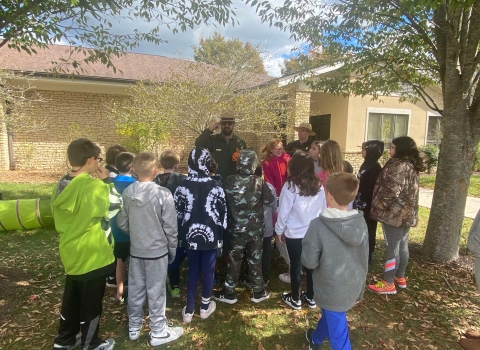It’s not easy being a frosted flatwoods salamander whose prospects can best be described as “bleak.”
Only three populations of the lovable amphibian are known to exist in what remains of the old longleaf pine forests of Florida, Georgia, and South Carolina. Climate change threatens the ephemeral ponds where the salamanders breed. One more wicked hurricane could wipe sallies from the map.
The salamander is listed as threatened under the Endangered Species Act.
But “the outlook for this species is so bleak,” the U.S. Fish and Wildlife Service says, that it should carry a more dire warning -- endangered.
Ah, but hope springs eternal and, due to some dogged acquisition and conservation work at the St. Marks National Wildlife Refuge near Tallahassee, the little frosties might just avoid the more perilous designation. It is, after all, American Wetlands Month, a time to honor the beauty and vitality of the oft-submerged ecosystems that sustain all manner of wildlife.
Example: Of the 65 freshwater ponds sampled this spring at St. Marks, salamanders showed up at 29 of them.
“That’s a pretty decent number,” said Chloë Dubben, a biological technician who recently left the Service. “It’s very exciting that, at one of those ponds, we’ve never caught salamanders before. It looks like we’re starting to rebound from the hurricane.”
Ah, the hurricane. Michael was its name and it was a Category 5 brute that pummeled the Panhandle in 2018 and, in addition to 16 deaths and $25 billion in damages, inundated egg-friendly ponds with saltwater. Sallie numbers plummeted after the storm.
It’s not as if they were in good shape before Michael arrived. Flatwoods salamanders once filled ponds across the longleaf pine forests of the Southeastern coastal plain. What was once 90 million acres of longleaf, though, has been reduced to maybe four million acres the last three centuries. Woodcutters, farmers, and developers laid waste to the longleaf empire.
In 2006, 52 ponds on St. Marks were occupied by salamander larvae. A decade later, only 11 ponds showed signs of sallies. Last year? Six ponds.
The changing climate doesn’t help. It’s often too hot, too wet, or too dry for the salamanders’ liking. Mama sallies lay their eggs in the dry depressions alongside the ponds and wait for rainfall to fill the hollows so the eggs can hatch. But if the rains don’t come – or come too late or too frequently – the larvae won’t survive. Climate-fueled hurricanes also push saltwater further into St. Marks’ forests and kill the grasses and forbs salamanders need to survive.
The refuge, though, has upped its salamander game the last few years with help from donors, interns, and partners. Thousands of acres of donated land have been added to the refuge’s northern flank, further from the Gulf of Mexico and “that pesky sea level rise,” as Dubben puts it. It was there, in one of those newly acquired northern ponds, that the salamander was captured for the first time this year.
The Service has restored some ponds in the north end, planted longleaf, and laid down some beneficial fire on thousands of acres. Biologists and interns have also collected larvae and relocated them to cattle tanks where they metamorphose into baby sallies before being returned to their ponds. Earlier his year, they collected 245 larvae and reintroduced more than 200 of them to different ponds to bolster genetic diversity. Twenty of the larvae were shipped to the Amphibian Foundation in Atlanta where, last year, a frostie was bred in captivity for the first time.
“There’s documentation that shows that head-starting increases salamander chances for survival in the wild,” said Amanda Bessler, newly named complex wildlife biologist for St. Marks, St. Vincent, Lower Suwannee, and Cedar Keys refuges. “It seems we’re slowly moving, at least, in a positive direction, but much needs to yet be learned.”
Dubben, too, is moving on. She has taken her scientific skills to the nearby Apalachicola National Forest where she’ll continue working to restore habitats, improve forests, and, yes, save salamanders.
“I’m cautiously optimistic – I really hope they do better,” Dubben said. “There’s a lot of people who care about salamanders. And, fingers crossed, let’s hope we don’t get any more, big storms.”




